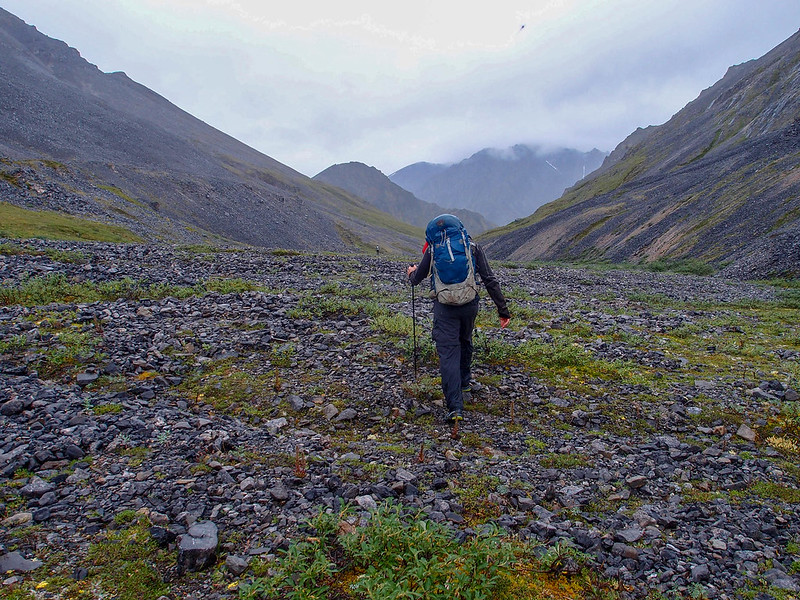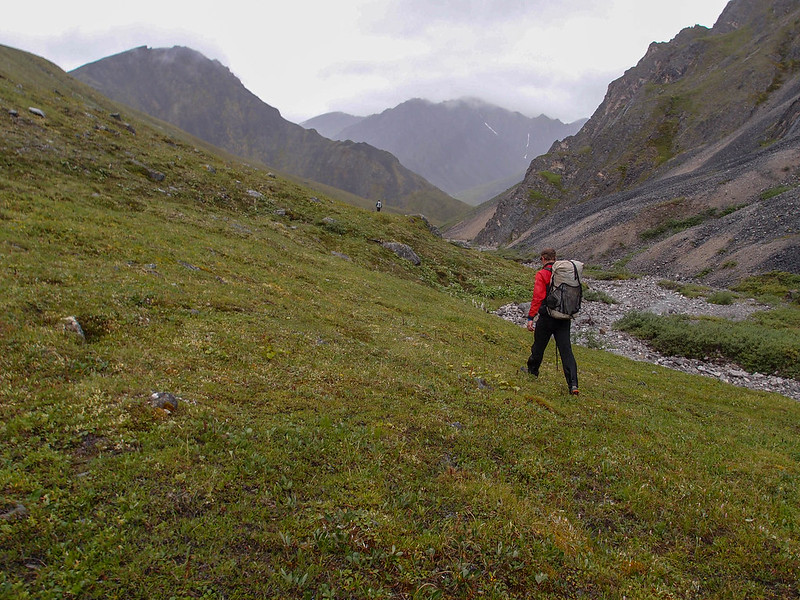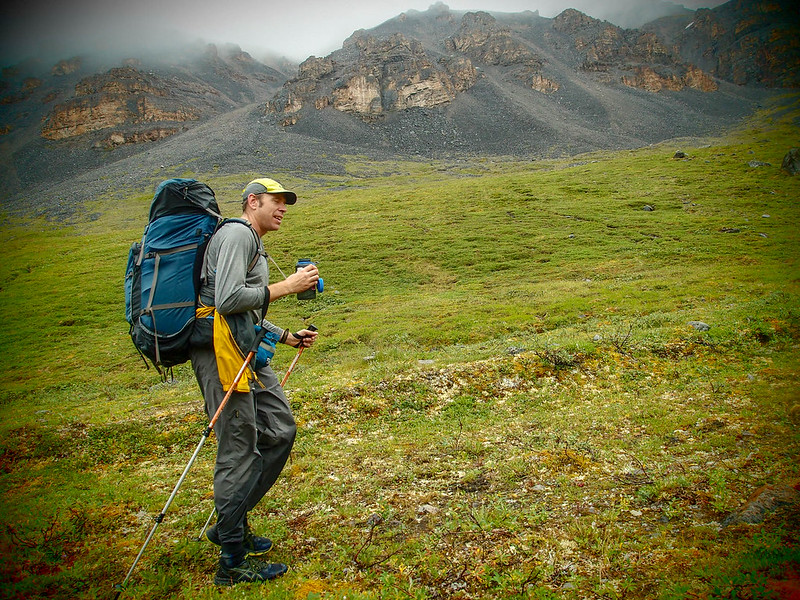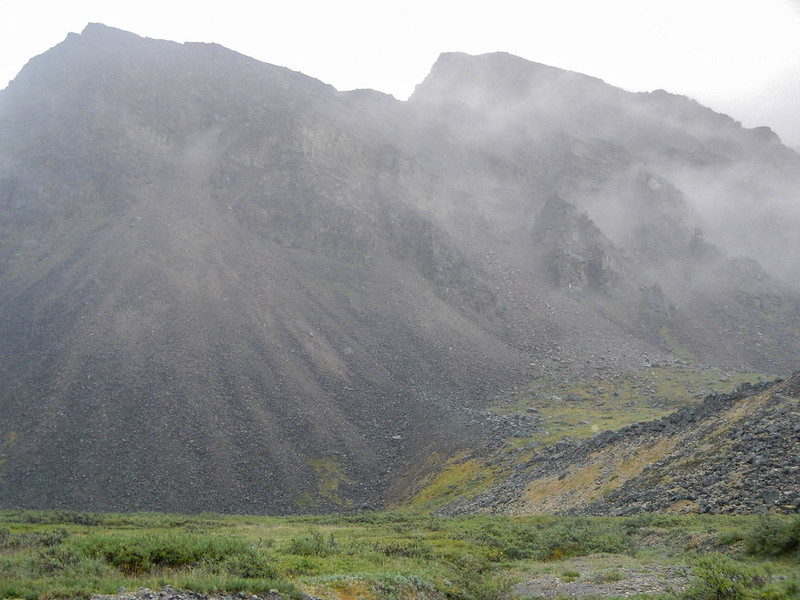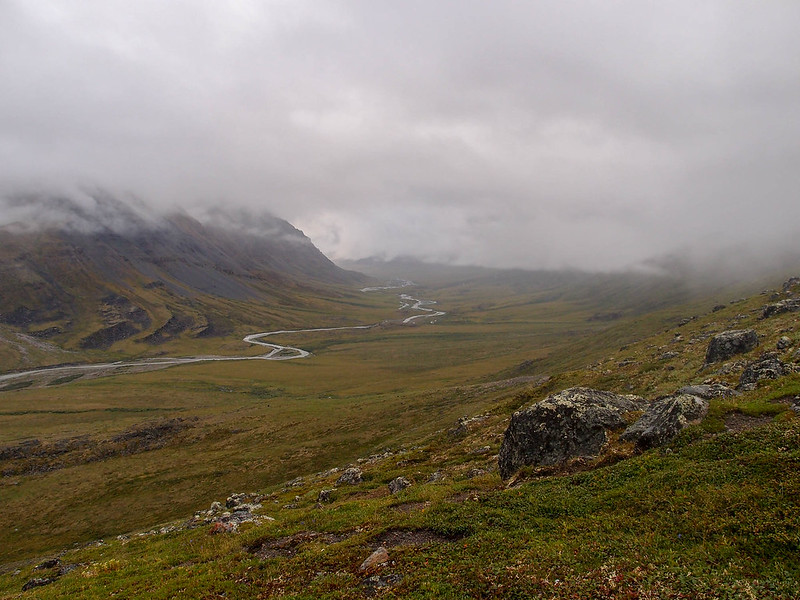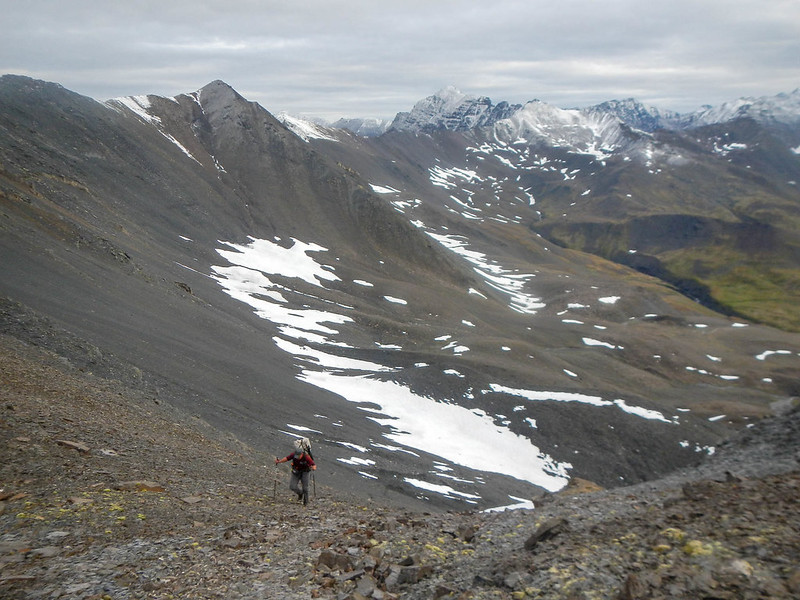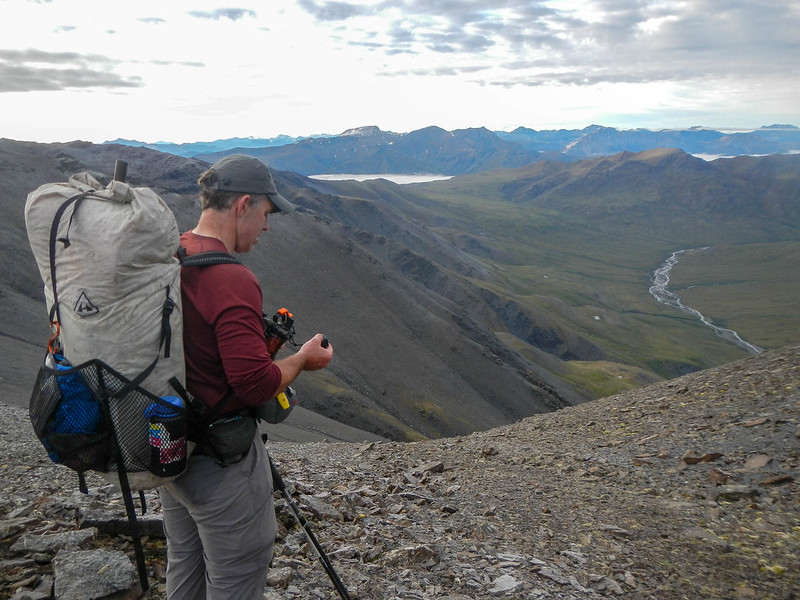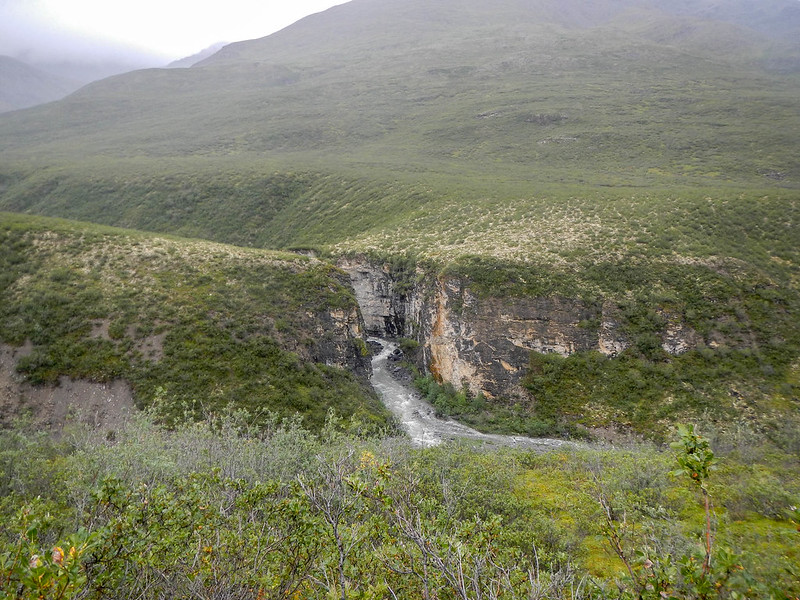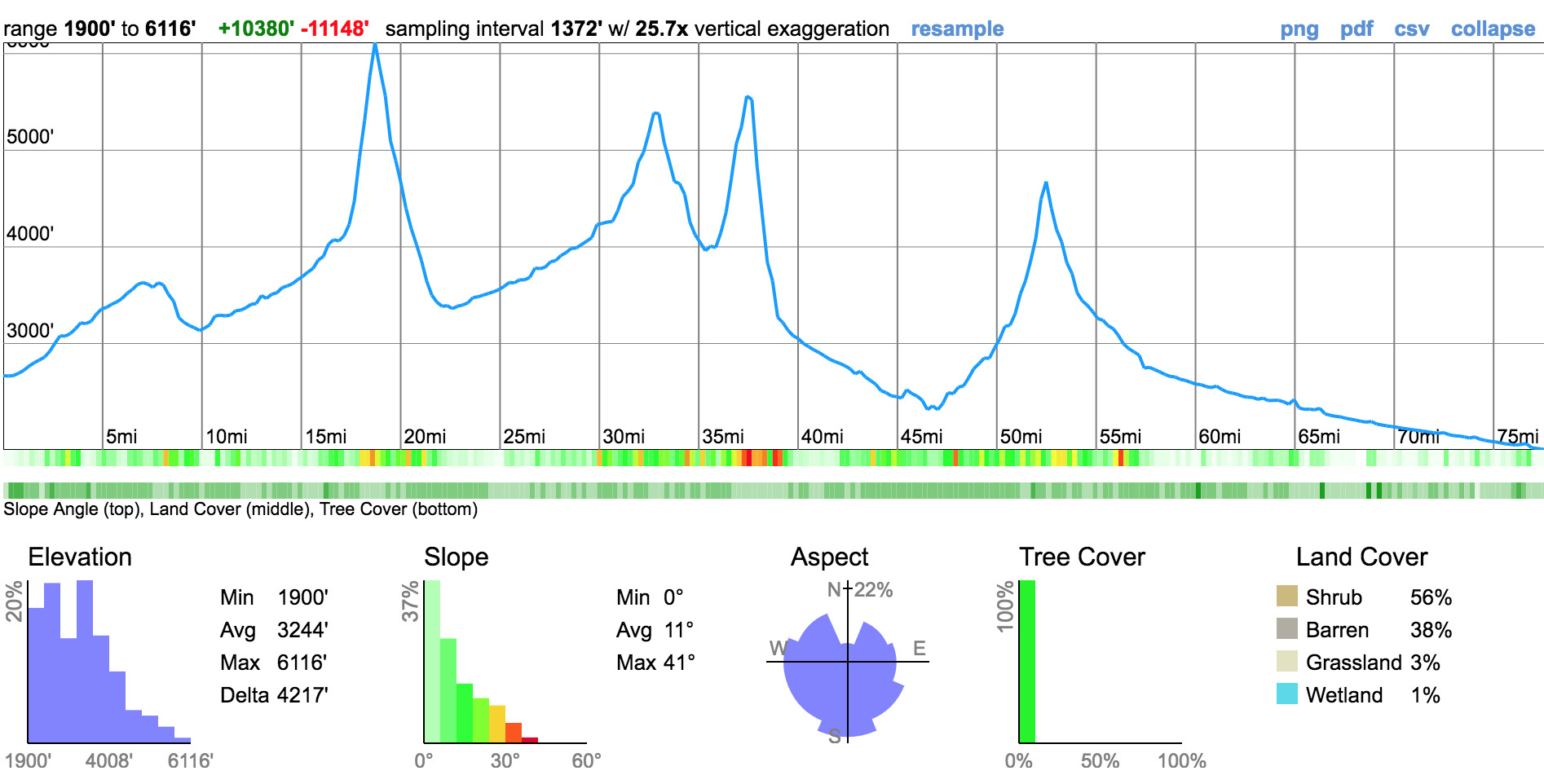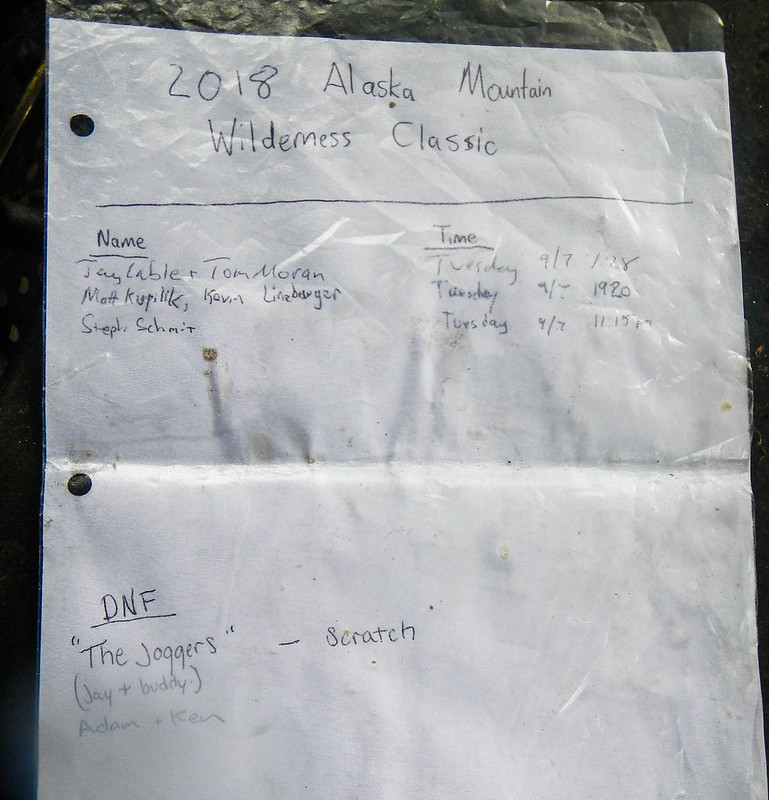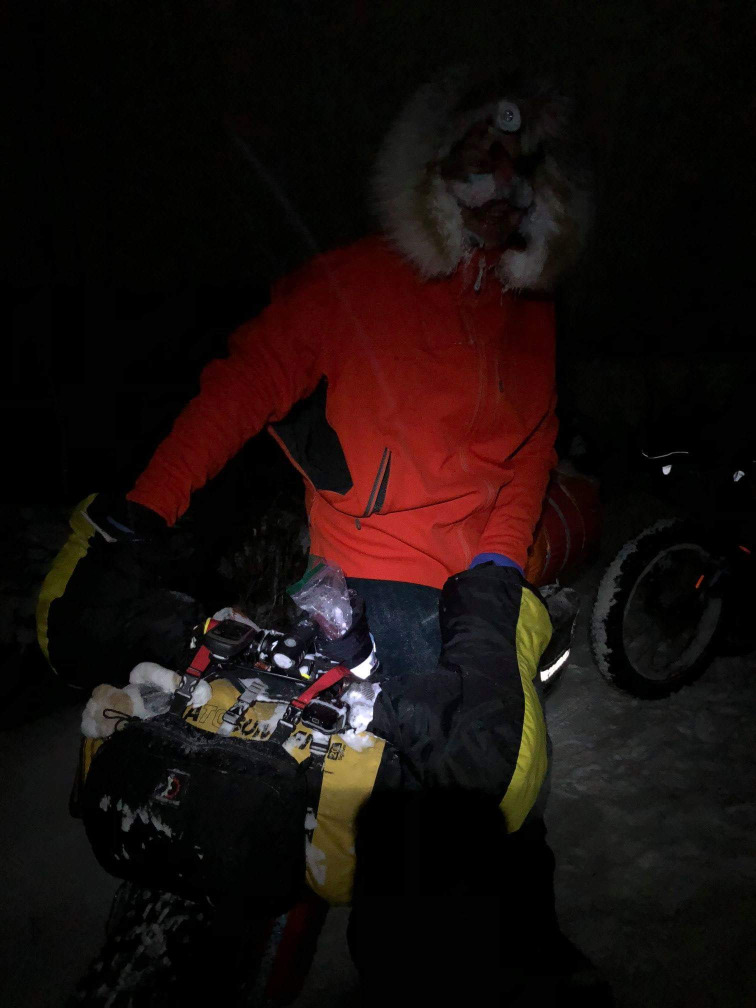
The evening was getting on – it was getting dark, a bit of snow was falling, and the wind was picking up, blowing snow around. Nina G and I were pushing up a little hill just before Low Lake around 20 miles from Rohn and 50 miles from Nicolia. It was the middle of nowhere, probably the remotest section of the Iditarod Trail before McGrath. As I pushed up the hill, I noticed some new looking boot tracks, that looked a lot like bunny boots. “Thats odd.” , I thought to myself, who could that be? As I reached the top of the hill, someone popped out of the woods and said “Hi Jay, would you like some coffee?!” . It took me a few moments to realize it was Gary Baumgartner, a Fairbanks area biker. I think Nina thought we were crazy – in the middle of nowhere someone pops out of the woods and knows who I am, and offers us coffee. Alas, we were in too big of a hurry, and passed on the coffee. I still regret not stopping longer to chat and enjoy that coffee..
First, some background.. The Iditarod Trail Invitational (ITI) is a race on the Iditarod trail from Knik (a small town, if one can even call it that outside Wasilla), to McGrath and Nome. The “Short” race ends at McGrath, and the “Long” race ends in Nome. The race starts a week before the Iditarod dog race starts, and while it is on the same basic course as the dog race, it isn’t affiliated with the dog race in any way.
I went into this year’s ITI with very mixed thoughts. The race had a few major shakeups. Bill Merchant is no longer involved with race, and there seemed to be more than the normal level of friction with some of the stops along the way, including not staying at the Petruska’s in Nikolai. To top it off, I was having a hard time getting excited about the first 300 miles to McGrath. There are lots of people, and the “fun” parts from Puntilla Lake to the Farewell Burn are book-ended by trail that is a bit ho-hum.
I drove down to Anchorage with a Fairbanks local, Lindsey, whom I met at last year’s Wilderness Classic. I was a bit stressed out by the race, and I think talked her to death on the way down, but it was neat to hear her talk about the race, and see the race again from the perspective of someone new.
Race day came, and my brother dropped me off at the race start (thanks John!), where I bounced around talking to people. It was great seeing Bill Fleming — one of the original minds behind 9zero7 bikes — who towed me into the finish during my first ride to Nome! I chatted with a few other people, including Andy P who had switched from his bike to mushing. Andy and I joked that we would run into each other on the trail. Andy said Old Woman Cabin, and I said Grayling. It turned out neither of us were right..
Soon the race started, and everyone channeled their energy into pedalling (or walking if you are crazy, or skiing in the case of Lindsey). As usual, the fast group hit the road, and I didn’t see them again, zooming away at high speed, while I chugged along at a slower pace. Eventually I hit the gas line, then Flat Horn Lake, and it felt like things were starting. The trail conditions were not awesome, but not that bad either. Eventually Yentna Station arrived, where I got the standard grilled cheese and soup, then headed out again for Skwentna. The trail was now fast, and I zoomed along, going perhaps a bit harder than I needed to. I arrived at Skwentna a bit after Kevin B, Kyle D, and Phil H, and well after Jay P, the other Nome-bound racers ahead of me. This was the start of the pattern to McGrath: I would arrive someplace a little after Kevin and Phil, and they would leave a bit before me. The McGrath-bound racers in the fast pack were all long gone. (Calling the race to McGrath “the “shorter race” has gotten me in trouble before.)
Skwentna is one of the few places I have found that I can get a good night sleep, besides Puntilla Lake, sometimes Rohn, and the Petruska’s in Nikoli, so I always try to get a nap there. I have found I need at least 4 hours of sleep a day to keep things together and to stay motivated. I can do less, but for the 20 or so days it could take me to get to Nome, I have found that it is hard to stay motivated and functional if I get less. Cindy, the owner of Skwentna, is always friendly, and the last few years seems to get me confused with Tim Stern, from 2012, which amuses me to no end. I got dinner, and headed up to find a bunk, only to find the room I was supposed to be in had a bleary looking Jay P in it, just waking up from a nap. Jay headed out, and I tucked myself in, and tried to get 4 or so hours of sleep.
In the morning I got a bit more to eat, and headed out, hoping to possibly grab lunch or breakfast at Shell Lake as I passed by. The Shell hills are always slow for me, as I just suck at biking uphill, but I eventually arrived at Shell Lake. Nearing the lodge, I was surprised to see a bunch of signs announcing that the lodge wasn’t an ITI checkpoint, and that ITI racers were not welcome. Yikes! The trail goes right by the lodge, so with a bit of trepidation I approached, and as I neared the lodge someone saw me, and invited me for breakfast. I sat down, enjoyed some pancakes, bacon, and a few cokes, and talked a bit with the folks helping out Zoe, the owner. It was a pretty interesting conversation, a short summary being that fat bikers were once a novelty, but now are commonplace, and folks are getting sick of the ITI racers. Apparently the racers have become a pain, and the business they bring isn’t offsetting the nuisance they are becoming: waking the owners up at odd hours, leaving messes, breaking into their buildings, sleeping in random places, etc. This made me pretty sad. I was left with the impression that a chunk of the ITI racers are not doing a good job of balancing their competitive drive with the need to be decent human beings on the trail. This doesn’t bode well for the long term, and I hope this changes.
The ITI isn’t a traditional race, with checkpoints staffed by the event and a closed course. Only Rohn is staffed by the ITI; the rest are private businesses, or people’s homes. The trail is shared by lots of other users, all of whom have just as much right ot be there as we do.
Eventually I headed out, and enjoyed a nice ride to Finger Lake, and then on to Puntilla. It was a bit windy, and some of the lakes before Puntilla were windy enough I had to walk sections, adding a bit to the experience. Eventually Puntilla arrived, and I hit the sack, enjoying a few hours of sleep before heading over the pass with Nina G. It was a bit slow up to the pass, with a bit of riding, and lots of walking, but we hit the top at around noon, and were soon zooming down to Rohn.

It looked like someone had taken the Iron Dog route, rather than turning and heading up into Rainy Pass. Later I was to learn that Jussi Karjalainen had taken the Iron Dog route when in 4th place, and had slowly made his way across the pass until a plane dropped a note saying he was off course. That must have been crushing.

It was midday, but I lay down for a bit of a nap after eating a brat and chatting a bit with Adrian. Kevin, Phil, and Aaron Gardner were also there, and headed out a bit before my nap finished.
After my nap, Nina and I headed out. I had hopes of making it to Nikolai by early morning, but alas that turned out to be a bit optimistic. The trail leaving Rohn was in great shape, and we made good time, but as we passed through the “new burn” the snow got deeper, and the riding got slower. Near Farewell Lakes there are a bunch of rollers, where the trail goes up and down as it passes over a bunch of little lakes. On one of these hills I noticed what looked like bunny boot prints, and soon after that someone came out of the woods and said hi. It took a few minutes for me to recognize Gary Baumgartner, a Fairbanks area biker. He offered us coffee and said hi. I passed on the coffee, and soon moved on. I was kicking myself later for not staying and hanging out with Gary a bit longer — sorry Gary! He looked like he was in a comfortable spot, tucked away with an Arctic Oven and his Supercub on a little lake.
The trail soon degraded. It was rideable in the treed areas, but in the open areas it was blown in, requiring a lot of pushing. Eventually, in the early a.m., Nina and I made it to Bear Creek cabin, where we soon had a fire going, and hit the sack. In the morning we headed out, just as Kevin arrived to warm up and dry out. The trail was much nicer from the turnoff to the cabin to Nikolai, and we made fairly good time. The Nikolai checkpoint had moved from the Petruska’s house to the village community center, which was a bit sad for me, since the Petruskas had always been a very welcoming place to me. And it was sad to know that Nick wouldn’t be there with a warm welcome. Alas…
The community center was easy to find, and Stephanie Petruska was there along with two ITI volunteers whose names I don’t remember. After a burger I crashed under a table to sleep for a few more hours. There was a bit of a group there: Kevin B., Arron G., Nina, and briefly Phil H., who left soon after arriving. In the early a.m., Nina, Arron, and I set out. It was a bit cold, slightly below zero, but the trail was fast and we made good time to the Big River junction, where the only trail in was the “overland” route. Billy Koitzsch’s race, the Iditasport, had an Arctic Oven set up near the junction, and there was a bike and several sleds pulled out outside it. I was tempted to say hi, but I expect Billy would not have been happy to get woken up.
Last year the miners in Ophir told me to take the “overland” route at Big River, as that is what all the locals use. Other folks had told me it was hit or miss — sometimes it was in only half way, leading folks to spend a lot of time wandering around in deep snow trying to find a trail. I was excited to get to try out the new route! Fortunately, the trail was in, and in great shape. At this point Kevin had caught up with us, and was zooming. Unfortunately, he zoomed ahead and took several wrong turns. I think Billy had put in some big loops to turn around his snowmachine and Kevin explored several of them, only to come out near where he started. Soon the trail was back in woods and lakes, the side trails disappeared, and Nina and I slowly made our way into McGrath. We arrived in McGrath in mid-morning, to a full house at the Tracy and Peter Schneiderheinze house. It was great to sit down, eat, talk, and take a brief break from the trail. Leaving McGrath is always hard, but there wasn’t a big hurry this year. The southern route doesn’t get much traffic (or so says common wisdom), so I wasn’t expecting a trail until the Iditarod trail-breakers came though.
I had been dreading the ride to McGrath. I have done it five other times now, and it is sort of old hat. The trail feels mostly the same from year to year, and I am always in a rush to stay ahead of the crowd. This year was a bit different though, and I got to see some new faces. I was pretty impressed by Aaron Gardner in particular; he had a very good race as a “rookie”, and I loved following his “line” — that is, the tracks of his tires from Bear Creek Cabin to Nikolai. He seemed to be always riding a fast line, and it wasn’t always the obvious one. He also bivied solo on the edge of one of the Farewell Lakes in windy, snowy conditions, which is not something a lot of rookies do. It was also great riding with Nina Gaessler, and meeting some of the other new faces like Neil Beltchenko.
I am sorry for the high word to picture content. I didn’t take a lot of photos, and this write-up grew longer than I expected it would be.
Next the southern route!
